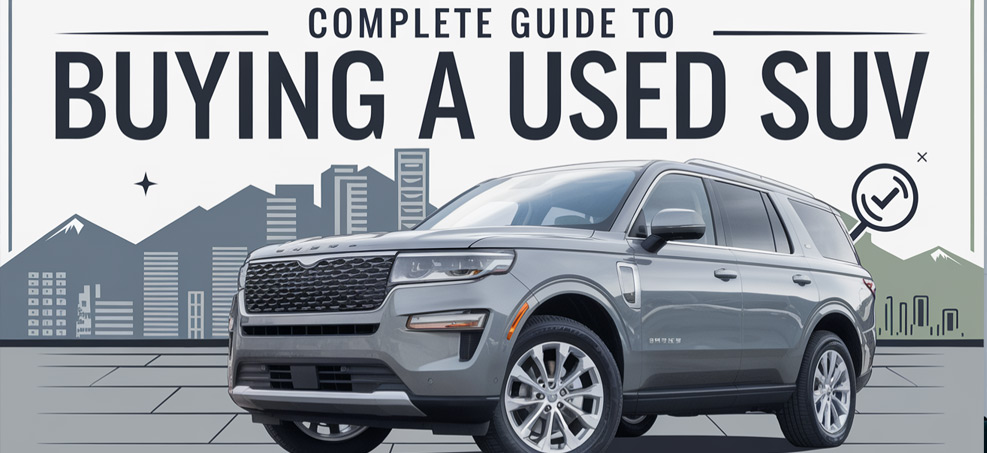Navigate the used SUV market with our complete guide to finding the best deal.
Buying a used SUV can be a smart investment, offering the space, versatility, and features of a new vehicle at a fraction of the cost. However, navigating the used car market comes with its own set of challenges.
From knowing what to look for mechanically to understanding the importance of vehicle history, this guide will walk you through everything you need to know before purchasing a used SUV.
1. Determine Your Needs and Budget
Before diving into the used SUV market, it’s important to first define what you need from your vehicle. Consider the following:
- Size: Are you looking for a compact, midsize, or full-size SUV? Smaller models like the Honda CR-V are ideal for city driving, while larger models like the Chevy Tahoe offer more passenger and cargo space.
- Purpose: Will you be towing or taking off-road trips? If so, a more rugged model with higher towing capacity, like a Toyota 4Runner, might be better suited to your lifestyle.
- Fuel Efficiency: Many SUVs are notorious for guzzling gas, but there are models, especially smaller or hybrid options, that offer better fuel economy.
Once you have a clear idea of your needs, set a realistic budget. Factor in not only the purchase price but also insurance, registration fees, and any repairs or maintenance the vehicle may require down the line.
2. Research the Best Used SUV Models
Not all SUVs age equally. Some models are known for their reliability, while others tend to experience more problems as they rack up miles. Here are a few well-regarded used SUV options:
- Toyota Highlander: Renowned for reliability, the Highlander has a reputation for longevity, making it a great option on the used market.
- Honda Pilot: A spacious and versatile family SUV, the Pilot offers solid performance and is known for being durable over time.
- Ford Escape: For those seeking a compact SUV, the Escape offers a comfortable ride and good fuel efficiency, making it a smart choice for city dwellers.
- Subaru Forester: With its standard all-wheel drive, the Forester is a great option for those in regions with harsh weather or those who enjoy off-road adventures.
Research the models you’re interested in to find out their typical resale value, reliability ratings, and common issues.
3. Check the Vehicle’s History Report
Before considering a used SUV, always obtain a vehicle history report from services like Carfax or AutoCheck. These reports can reveal critical information such as:
- Accidents: Any past accidents the vehicle was involved in, which can help you determine if the car has suffered structural damage.
- Ownership History: A car with fewer previous owners, especially if they’ve kept it for longer periods, is generally a safer bet.
- Maintenance Records: Check if the vehicle has been regularly maintained, as skipping routine maintenance can lead to costly repairs down the line.
- Title Status: Make sure the vehicle has a clean title, meaning it hasn’t been salvaged or rebuilt after major damage.
This step is crucial in avoiding potential pitfalls that could turn your dream SUV into a nightmare.
4. Have the Vehicle Inspected by a Mechanic
Even if the SUV looks great on the outside, there could be hidden problems that are only detectable with a professional inspection. Independent mechanics can help you identify:
- Engine and Transmission Issues: Check for leaks, odd noises, or rough shifting, which could indicate expensive repairs in the future.
- Brake and Suspension Wear: These are common areas that need attention in used vehicles, especially in larger SUVs that endure more wear and tear.
- Tires: Inspect for uneven wear, which could point to alignment issues or suspension problems.
Spending a little extra to have the SUV inspected could save you thousands in unexpected repairs later on.
5. Evaluate the Condition Inside and Out
While a mechanic can tell you about the vehicle’s mechanical health, it’s up to you to assess the condition of the interior and exterior. Look for:
- Exterior Damage: Check for signs of rust, dents, or mismatched paint, which could indicate previous damage or lack of care.
- Interior Wear: Inspect the seats, dashboard, and upholstery for signs of excessive wear or damage, particularly in high-traffic areas like the driver’s seat.
- Technology and Features: Make sure all electronics, including the infotainment system, backup camera, and climate controls, are functioning properly.
Small issues might not be deal-breakers, but they can give you room to negotiate on price.
6. Take a Test Drive
A test drive is essential for any used vehicle purchase. While driving, pay attention to how the SUV feels and sounds. Keep an eye out for:
- Steering and Handling: Is the SUV easy to maneuver, and does it respond well to turns? A test drive will help you assess the comfort and control of the vehicle.
- Braking: Do the brakes respond smoothly, or do you hear any unusual squeaks or grinding noises?
- Noise Levels: Listen for any rattling, squeaking, or other odd noises from the engine or suspension that could indicate problems.
Take the SUV on a variety of roads—highways, residential streets, and even rougher surfaces if possible—to get a full sense of how it handles.
7. Negotiate the Price
If the vehicle is in good shape but has a few minor issues, don’t hesitate to negotiate. Use the Kelley Blue Book or Edmunds to check the fair market value for the SUV, based on its year, condition, and mileage. Be prepared to offer a lower price if the SUV needs repairs or maintenance.
8. Finalize the Purchase and Paperwork
Once you’ve agreed on a price, ensure that all paperwork is in order. This includes the title, bill of sale, and any necessary emissions or safety inspections. Make sure the VIN (Vehicle Identification Number) on the title matches the VIN on the vehicle, and double-check that there are no liens or outstanding issues with the car’s registration.
Drive Home with Confidence
Buying a used SUV can feel overwhelming, but following this guide will help you make an informed decision. With thorough research, a careful inspection, and some negotiation, you can drive home with an SUV that fits your budget and lifestyle. Happy shopping!


